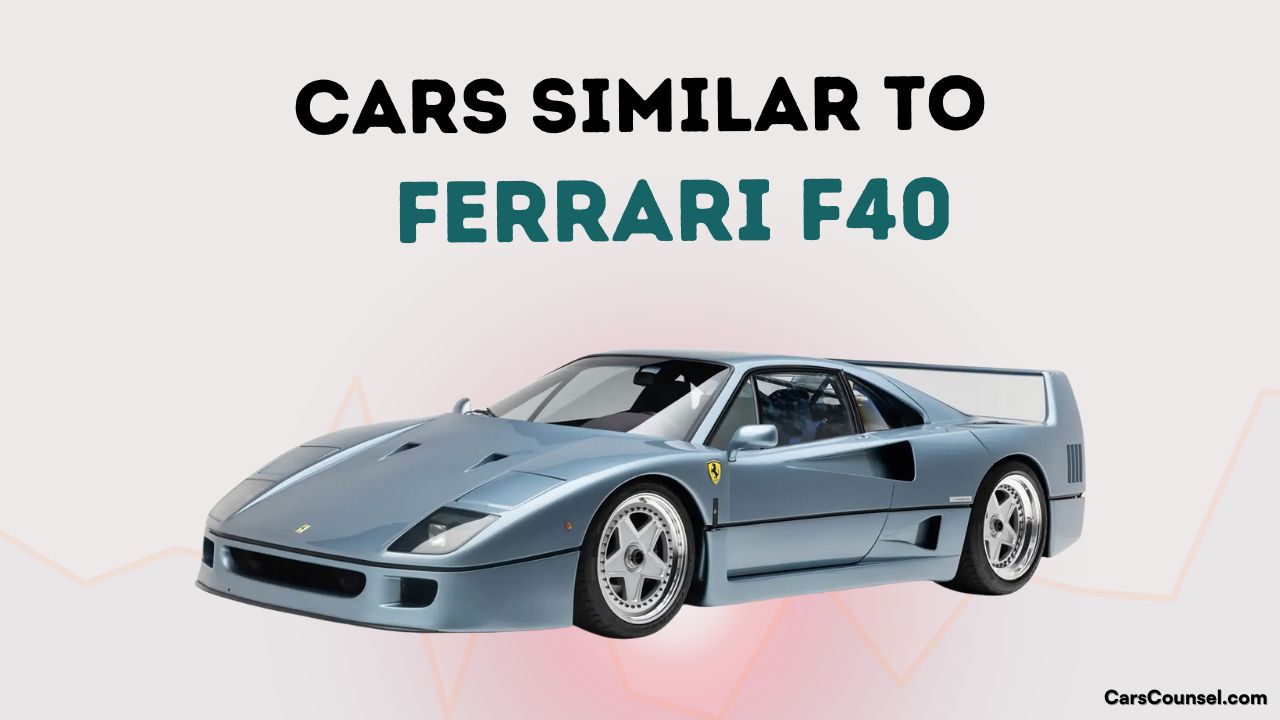Did you know that only 1,315 Ferrari F40s were produced between 1987 and 1992? This exclusivity, combined with its incredible performance, has made the F40 a holy grail for collectors and enthusiasts.
But if you can’t get your hands on one, other 80s supercars share its spirit. You might be surprised to find that cars like the Porsche 959 and Isdera Imperator 108i offer similar thrills, and their unique features might just make them worth a closer look.

Quick Navigation
Key Takeaways
- The Porsche 959 is a similar supercar with advanced technology and luxury features, but prioritizes stability and control over raw power delivery.
- The Isdera Imperator 108i shares the F40’s exclusivity and high-performance capabilities, with a longitudinally-mounted V8 engine and gullwing doors.
- The Lancia Delta S4 Stradale, as a rally-bred superstar, offers a similar focus on raw performance and handling, with a mid-mounted engine and four-wheel-drive system.
- The Ferrari 288 GTO, as a precursor to the F40, shares similarities in design and performance, with a 2.85-litre turbocharged engine producing 400hp.
- These supercars of the 1980s, including the F40, prioritized speed and performance, often sacrificing comfort and convenience features in the process.
80s Supercars That Redefined Speed
As the 1980s unfolded, you found yourself in the midst of a high-stakes game of one-upmanship, where manufacturers pushed the performance envelope to unprecedented extremes.
Ferrari’s 288 GTO, with its 400hp and 189mph top speed, set the bar high. However, other supercars quickly followed suit.
The Isdera Imperator 108i reached 176mph, while the Lancia Delta S4 Stradale maxed out at 140mph.
The Porsche 959, with its twin-turbo flat-six engine, took the crown with a 197mph top speed.
These supercars redefined speed, leaving all else in their wake.
The Ferrari 288 GTO: A Legendary Precursor
While Ferrari’s 288 GTO wasn’t the first supercar to dominate the 1980s, its influence paved the way for future speed demons like the F40.
You’ll notice significant modifications to meet Group B regulations, including fibreglass, Kevlar, and carbon-fibre body panels, and a stretched wheelbase to accommodate the longitudinal V8 engine.
This 2.85-litre turbocharged engine produces 400hp, reaching 189mph and accelerating from 0-60mph in just 5.0 seconds.
With only 272 units produced between 1984 and 1987, the Ferrari 288 GTO is a highly sought-after collector’s item today, showcasing Ferrari’s innovative spirit in the F series.
Isdera Imperator 108i: The Mercedes-Porsche Hybrid
You’ll be hard-pressed to find a car that blends German engineering and Italian flair like the Isdera Imperator 108i, a true hybrid of Mercedes and Porsche parts.
This rare supercar boasts a longitudinally-mounted 5.0-liter V8 engine, side-exit exhausts, and gullwing doors.
While it lacks all-wheel drive, its rear-mounted engine and advanced technology, reminiscent of the Porsche 959, make it a formidable performer.
With a top speed of 176mph, the Imperator 108i is an exclusive powerhouse, but its high development costs and limited production make it a rare find.
Lancia Delta S4 Stradale: The Rally-Bred Superstar
You’re about to experience the thrill of a rally-bred superstar, the Lancia Delta S4 Stradale, which evolved from its Group B heritage to become a legendary performer.
Born from the intense competition of rally racing, this car’s design focused on raw performance and handling, rather than luxury and comfort.
With its cutting-edge tech and remarkable acceleration, you’ll understand why it’s a worthy counterpart to the Ferrari F40.
Rally Heritage Evolved
As the World Rally Championship’s Group B regulations sparked innovation, Lancia responded with the Delta S4 Stradale, a road-going iteration of their rally-bred superstar.
You’ll appreciate the cutting-edge technology that trickled down from Lancia’s rally cars, such as the four-wheel-drive system, which sent power to all four wheels, not just the rear wheels.
This rally heritage evolved into exceptional handling and grip, making the Delta S4 Stradale a formidable competitor.
With its 250hp mid-mounted engine, you’ll experience a 0-60mph time of around six seconds and a top speed of 140mph, solidifying its status as a true rally-bred superstar.
Group B Legend Born
The Lancia Delta S4 Stradale‘s creation was a direct response to the World Rally Championship‘s Group B regulations, and its resulting design reflected a perfect blend of form and function.
You’ll appreciate its mid-mounted engine, which was both turbocharged and force-boosted to produce 250hp. The Stradale’s advanced four-wheel-drive system, space-frame chassis, and double wishbones all-round made it a highly capable rally competitor.
With only 200 units built for homologation, this rare Group B legend is a coveted addition to any car collection, boasting a 0-60mph time of six seconds and a top speed of 140mph.
Porsche 959: The Ultimate All-Weather Supercar
You’re about to experience the Porsche 959, a masterclass in combining design and luxury with power and performance.
With its 450bhp, twin-turbocharged flat-six engine and advanced four-wheel-drive system, this supercar is designed to conquer any road condition.
Meanwhile, its luxurious cabin, climate control, and active damping guarantee that you’ll be comfortable and in control, no matter the weather, and certify that your ride will be smooth and enjoyable.
Design and Luxury
Luxury is not a word typically associated with the Ferrari F40, but its Porsche 959 counterpart boasts a lavish interior that’s a stark contrast to the F40’s Spartan cabin. You’ll find climate control, electric windows, and a well-appointed cabin in the 959, a far cry from the F40’s bare-bones setup.
| Feature | Ferrari F40 | Porsche 959 |
|---|---|---|
| Body Panels | Kevlar | Kevlar |
| Interior | Spartan, no carpets | Luxurious, sound deadening |
| Windows | No electric windows | Electric windows |
| Seating Position | Low, racecar-like | Upright, sedan-like |
| Visibility | Limited | Excellent all-round |
Power and Performance
As you plunge into the domain of high-performance driving, the Porsche 959’s twin-turbo 2.85-litre flat-six engine stands out, producing a staggering 450bhp that made it the most powerful 911 variant at the time.
With a 0-60mph time of 3.6 seconds, the 959 is just seconds slower than the Ferrari F40, making it a formidable rival in the sports car arena.
This performance powerhouse boasts a top speed of 197mph, solidifying its position as one of the fastest cars of its era.
The 959’s advanced technology and all-weather capability make it a more practical and accessible supercar.
Handling and Comfort
When you swap the Porsche 959 for the Ferrari F40, you’ll immediately notice a stark contrast in their ergonomics and amenities.
The 959’s more upright seating position and advanced traction control systems provide better handling and comfort, especially in varying driving conditions.
In contrast, the F40’s racecar-like seating position and lack of traction control can make it more challenging to handle.
Additionally, the 959’s higher ride height and excellent all-round visibility make it a more practical car for everyday driving, while the F40’s limited visibility and stripped interior compromise comfort for the sake of lightness.
Giocattolo Group B: Australia’s Forgotten Supercar
How did a supercar project born in Australia, inspired by Alfa Romeo‘s stillborn Group B endeavor, manage to fly under the radar of even the most ardent enthusiasts?
You’re about to discover the Giocattolo Group B, a rare bird that’s often overlooked in the world of supercars.
This Aussie-built car boasted a mid-mounted Holden 5.0-litre V8 engine and a ZF transaxle driving the rear wheels, with Kevlar panels replacing bodywork to reduce weight.
Launched by Aussie F1 champ Alan Jones, it was fast but expensive, with only 15 built before the factory closed.
Design and Performance: A Comparison of the F40 and 959
When comparing the Ferrari F40 and Porsche 959, you’ll notice they share similar design cues, such as their wedge-shaped profiles and pop-up headlights.
However, their engines tell a different story, with the F40’s mid-mounted V8 contrasting the 959’s 2.8-litre flat-six with twin, sequential turbocharging.
As you examine these powerplants, you’ll uncover distinct approaches to performance, each with its advantages and trade-offs.
Design Similarities
The Ferrari F40 and Porsche 959, two iconic supercars of the 1980s, share some striking design similarities despite their distinct visual identities.
You’ll notice both cars feature body shells made largely from Kevlar, a lightweight and high-strength material. Although the F40’s air inlets are more obvious, both cars prioritize aerodynamics.
The F40’s rear wing is a prominent design feature, whereas the 959’s is more subtly integrated. While the F40’s design is more angular, both cars boast sleek, performance-oriented designs that set them apart from other vehicles of the era.
Engine Differences
You’re likely drawn to the Ferrari F40 and Porsche 959 for their exceptional performance, and a significant portion of that comes from their engines.
The Ferrari’s V8 engine boasts parallel twin turbos, whereas the Porsche’s flat-six engine features sequential twin turbos, resulting in distinct power delivery characteristics.
With a higher rev limit of 7,750 rpm, the F40’s engine produces 478bhp, outpowering the 959’s 450bhp.
Additionally, the F40’s air-cooled block and unique fuel injection system differ from the 959’s water-cooled cylinder heads and Bosch Motronic 2.1 system, impacting their cooling systems and fuel efficiency.
Engine and Powertrain: Where the F40 and 959 Differ
Beneath their sleek, high-performance bodies, the Ferrari F40 and Porsche 959 boast distinct engine and powertrain configurations that set them apart from each other.
You’ll find a V8 engine in the Ferrari, whereas the 959 features a flat-six engine.
The F40’s parallel twin turbos differ from the 959’s sequential twin turbos, resulting in unique power delivery characteristics.
Additionally, the 959’s Bosch Motronic 2.1 fuel injection system contrasts with the F40’s fuel injection system, impacting engine performance and efficiency.
These differences in engine technologies contribute to distinct driving experiences and capabilities.
Handling and Performance: Raw Vs Refined
As you step behind the wheel of the Ferrari F40 or Porsche 959, it’s clear that these supercars cater to different driving preferences.
The F40’s raw power delivery, courtesy of its parallel twin turbos and air-cooled block, is ideal for track-focused driving.
In contrast, the 959’s sequential twin turbos and water-cooled cylinder heads provide a more refined and technologically advanced power delivery, making it a better road car for everyday driving.
The F40’s lightweight construction and suspension setup prioritize agility, while the 959’s advanced traction control systems and all-wheel drive guarantee stability and control in various conditions.
Characteristics and Conclusion: Two Cars, Two Purposes
While the Ferrari F40 and Porsche 959 share a common purpose as supercars, their characteristics and design philosophies plunge significantly.
You’ll find the F40 is a track-focused Ferrari, stripped of comfort and convenience features, with a rear-wheel drive layout and a track-ready ride.
In contrast, the 959 is an all-round supercar with a more accessible torque curve, making it easier to drive.
Either car serves a distinct purpose: the F40 caters to enthusiasts craving rawness and brutality, while the 959 is for those seeking a comfortable and refined modern car experience.
When exploring alternatives, make sure to checkout other similar models like Ferrari Testarossa, Ferrari Purosangue, Ferrari Roma, and Ferrari 812. Comparing these vehicles side by side helps you see where each stands out in terms of price, performance, features, and reliability. Our in-depth breakdowns highlight which alternatives make the best fit for different drivers. By reviewing these, you’ll discover which competitors best match your driving needs and lifestyle.
Conclusion
As you stand at the crossroads of speed and sophistication, the Ferrari F40 and Porsche 959 await, each a distinct path to enlightenment. The F40, a raw and unbridled stallion, gallops forward with unrelenting ferocity. The 959, a finely-tuned orchestra, harmonizes power and poise. Choose the F40 for an unapologetic adrenaline rush, or the 959 for a symphony of speed. The road ahead is yours, where will you drive?

